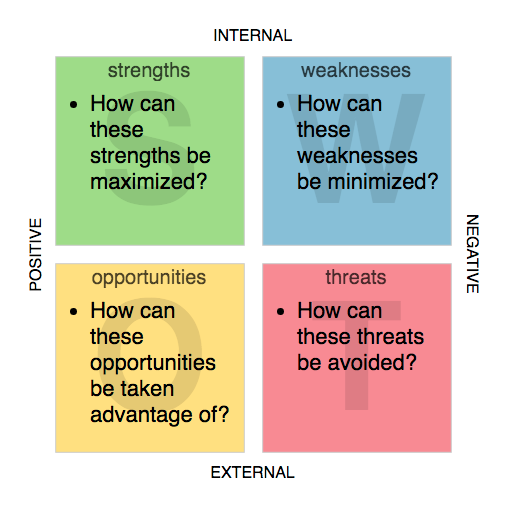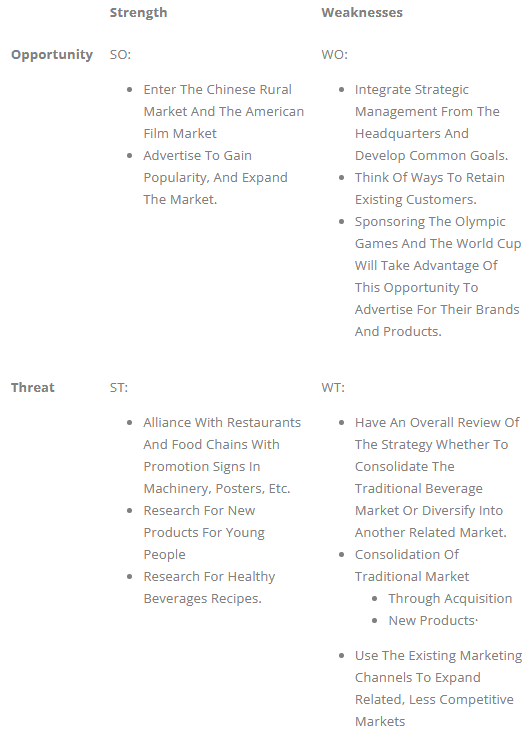How to formulate Actions After SWOT Analysis
What is SWOT analysis?
SWOT analysis is a technique developed at Stanford in the 1970s, frequently used in strategic planning. SWOT is an acronym for Strengths, Weaknesses, Opportunities, and Threats and is a structured planning method that evaluates those four elements of an organization, project or business venture. A SWOT analysis is a simple, but powerful, framework for leveraging the organization’s strengths, improving weaknesses, minimizing threats, and taking the greatest possible advantage of opportunities.

Internal vs External Factors
In the SWOT analysis, all internal factors (i.e., strengths and weaknesses) should be grouped together and then evaluated by external forces (opportunities and threats).
Strengths and weaknesses analysis of internal conditions (S-W) is an internal evaluation method. The main objective is to identify the relationship between expertise and capabilities and conditions within the organization.
The Strengths and weaknesses of internal conditions are internal factors that an organization can control, including financial resources, technical resources, research and development, organizational culture, human resources, product characteristics, marketing resources, etc.
External factors (opportunities and threats)
With the rapid development of economy, technology and many other aspects, especially the acceleration of the globalization and integration of the world economy, the establishment of global information network and the diversification of consumer demand, enterprises are in a more open and changeable environment. This change has had a profound impact on almost all businesses. Therefore, environmental analysis has become an increasingly important function of enterprises.
Opportunity and Threat (O-T) analysis is an external environment assessment method. Its main purpose is to determine the relationship between Opportunity and Threat from the external industrial environment refer to external factors that beyond the control of an organization, including competition, politics, economy, law, society, culture, science and technology, population and environment, etc.
Strength
- Brand Identity: Amazon Is Synonymous With Online Sales Services, And Amazon Focuses On Improving Customer Satisfaction During The Business Process.
- Pioneer Advantage: Amazon Is Undoubtedly The Leader In The Online Retail Industry.
- Cost Structure: Amazon Effectively Uses Its Cost Advantage, Operates On Thin Profits, And Is Still Profitable In Trading.
- Business Development: Amazon Continuously Improves Its Service Level And Provides Diversified Services.
Weakness
- Low-Profit Margins: Amazon Has A Very Thin Profit Margin To Maintain Its Cost-Leading Strategy. But Low-Profit Margins Make Companies Vulnerable To External Shocks And Crises, As Well As Other Market Changes.
- Seasonality: There Is A Seasonal Difference Between Amazon’s Revenue And Business Scope, With Sales And Revenue Peaking In The Fourth Quarter Of Each Year.
Opportunity
- Today’s Diversification Of E-Commerce Business
- Continues To Increase Awareness Of Its Own Branded Products And Services.
- Amazon Develops More Local Websites To Participate In The International Market. With The International Expansion Of Amazon, Some Local Businesses Have The Opportunity To Enter The International Market.
- Promoting The Strategic Cooperation Between Amazon E-Commerce And Its Related Affiliated Industries Will Drive Positive Development Of The Industry
Threat
- Loss Of Profits Due To Low-Profit Margins
- Patent Infringement And Other Aspects Of Amazon’s Litigation
- E-Commerce Industry Barriers To Entry Barriers
- Cybersecurity Issues
Example: Coca-Cola SWOT Analysis Example

Coca-Cola Detailed SWOT Analysis

Formulating Actions for SWOT Analysis
Having completed a SWOT Analysis, so what’s next? Is this enough to conduct the SWOT analysis? You need to know when you are analyzing that at the end of the process you need to expect future directions for next actions. Here is an example of formulating actions for a SWOT analysis:

This post is also available in Deutsch, Español, فارسی, Français, Bahasa Indonesia, 日本語, Polski, Portuguese, Ру́сский, Việt Nam, 简体中文 and 繁體中文.













